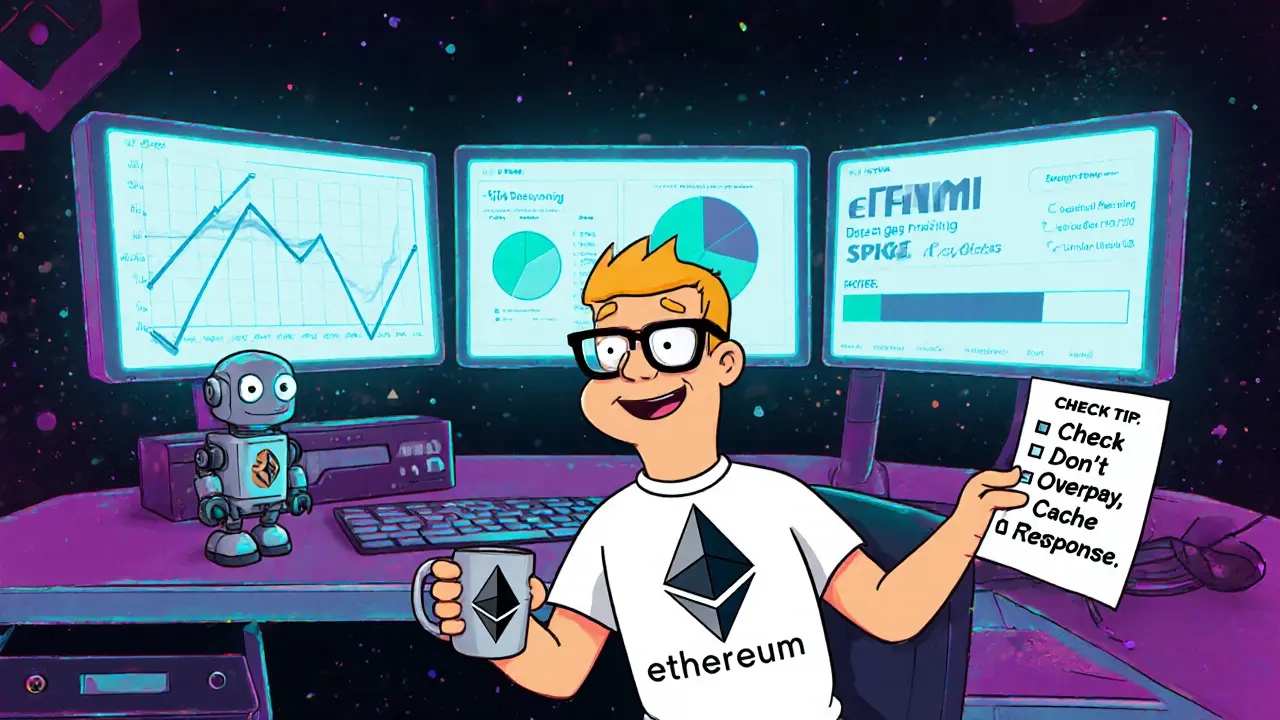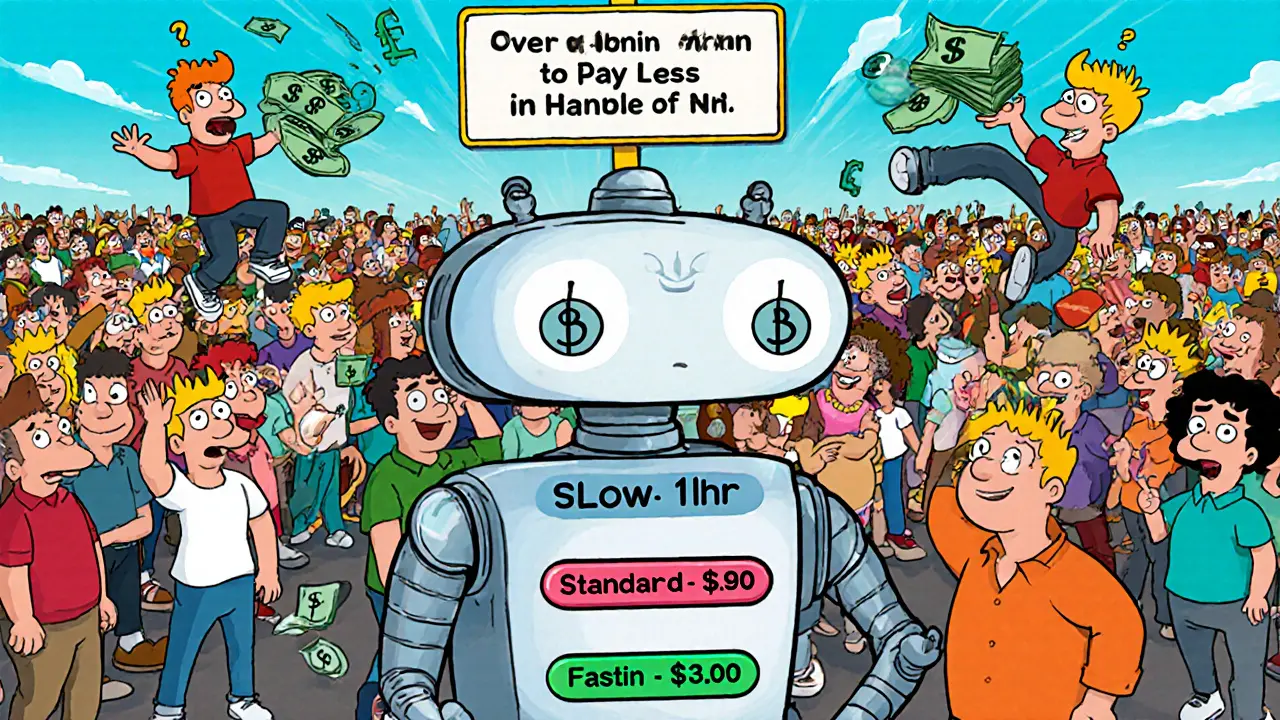Blockchain Transaction Fee Calculator
Bitcoin Fee Calculator
Ethereum Fee Calculator
Bitcoin Transaction Fee Estimate
Ethereum Transaction Fee Estimate
Why transaction fee estimation tools matter more than ever
Ever sent a Bitcoin transaction and waited hours-or even days-for it to confirm? Or paid $15 in gas fees on Ethereum for a simple token swap that should’ve cost $0.50? You’re not alone. Blockchain networks aren’t just fast digital ledgers-they’re crowded highways where every transaction competes for space. Without the right fee estimation tool, you’re either overpaying or getting stuck in the digital traffic jam.
Transaction fee estimation tools solve this by predicting the exact fee needed to get your transaction confirmed quickly, without wasting money. They don’t guess. They analyze real-time data from the mempool (the waiting room for unconfirmed transactions), track how fees changed in the last 10 blocks, and adjust based on network congestion. In 2025, with DeFi, NFTs, and institutional crypto adoption growing, these tools aren’t optional-they’re essential.
How Bitcoin fee estimation works (sat/vB explained)
Bitcoin doesn’t use dollars or cents for fees. It uses satoshis per virtual byte (sat/vB). One satoshi is 0.00000001 BTC. A typical Bitcoin transaction is around 200-300 vB. So if the recommended fee is 50 sat/vB, your total fee would be 10,000-15,000 satoshis, or roughly $0.30-$0.50 depending on BTC price.
During quiet periods, fees can drop to 10-20 sat/vB. But when the network gets busy-like during a major NFT drop or Bitcoin ETF news-fees spike to 80-120 sat/vB or higher. Tools like Lightspark and Cobo monitor the mempool in real time, tracking how many transactions are waiting and at what fee levels. They then suggest three tiers: slow (1-2 hours), standard (15-30 minutes), and fast (under 10 minutes).
Here’s the catch: if you pick the slow option during peak time, your transaction might not confirm for 6+ hours. If you pick fast when it’s not needed, you’re throwing money away. That’s why accurate estimation matters.
Ethereum’s fee system after EIP-1559 (base fee + tip)
Ethereum changed everything in August 2021 with EIP-1559. Before that, users bid against each other in auctions. Now, fees are split into two parts:
- Base fee: Automatically burned, set by the network based on demand. It goes up when blocks are full, down when they’re empty.
- Priority fee (tip): Extra amount you add to incentivize miners or validators to include your transaction first.
Total fee = (gas limit) × (base fee + tip)
Gas limit is how much computational work your transaction needs. A simple ETH transfer uses 21,000 gas. A DeFi swap might use 100,000-250,000 gas. The base fee fluctuates constantly-sometimes under 10 gwei, sometimes over 100 gwei. Tools like CryptoAPIs and Tatum track this in real time and suggest optimal tips based on your urgency.
For example: If the base fee is 25 gwei and you add a 5 gwei tip, your total cost per gas unit is 30 gwei. For a 100,000-gas swap, that’s 3,000,000 gwei = 0.003 ETH. At $3,000 per ETH, that’s $9. But if you tip 20 gwei instead, you’re paying $36. Most users overpay by 2-3x because they don’t understand this system.

Top 5 transaction fee estimation tools in 2025
Not all tools are built the same. Some are simple web calculators. Others are enterprise-grade APIs with machine learning. Here are the most reliable options right now:
| Tool | Networks Supported | Estimation Method | Accuracy (Normal Conditions) | Best For |
|---|---|---|---|---|
| Lightspark | Bitcoin, Lightning Network | Mempool analysis + predictive modeling | 92% | Bitcoin traders, Lightning users |
| Cobo | Bitcoin, Ethereum, Solana, Polygon | Real-time API + tiered urgency settings | 89% | Developers, wallet integrations |
| CryptoAPIs | 15+ blockchains (EVM, UTXO, others) | Multi-chain fee aggregation + historical trends | 87% | Multi-chain dApps, exchanges |
| Tatum | Bitcoin, Ethereum, TRON, BSC | Fee comparison engine + network-specific logic | 85% | Enterprise crypto payments |
| FENN Framework | Bitcoin, Ethereum (research) | Neural network trained on 2M+ transactions | 95% | Advanced developers, academic use |
Lightspark is the go-to for Bitcoin users who rely on the Lightning Network. It doesn’t just estimate on-chain fees-it optimizes off-chain routing too. Cobo stands out because it lets you pick urgency levels (e.g., “confirm in 5 min”) and automatically adjusts the tip. CryptoAPIs is the most versatile-it covers everything from Solana to Arbitrum. Tatum is great if you’re comparing fees across chains before sending. And FENN? It’s the future. Developed in 2024, it uses AI to predict fee spikes before they happen, outperforming older models by 15-20% in accuracy.
What goes wrong with fee estimation (and how to avoid it)
Even the best tools fail under extreme conditions. Here are the most common mistakes:
- Using static fee sliders: Many wallets still show “Low, Medium, High” buttons. These are outdated. During congestion, “High” might still be too low.
- Ignoring network type: Ethereum fees behave differently than Bitcoin. Don’t assume what works on one chain applies to another.
- Not checking real-time data: A fee estimate from 30 minutes ago is useless if the mempool just filled up.
- Overpaying out of fear: Users often double or triple the suggested tip. In 2024, 68% of Ethereum users overpaid by 2x or more, according to blockchain analytics firm Dune.
- Forgetting gas limits: A low gas limit can cause a transaction to fail, even with a high tip. Always check the recommended limit for your transaction type.
Pro tip: Use a tool that shows you the last 10 blocks’ confirmed fees. If your estimated fee is below the 50th percentile, you’re risking delay. If it’s above the 90th, you’re probably overpaying.

How to integrate fee estimation into your app or wallet
If you’re a developer, integrating fee estimation is easier than you think. Most providers offer REST APIs with SDKs in Python, JavaScript, and Java.
Here’s the basic flow:
- Send a request to the API with: transaction type (transfer/swap/contract), source/destination addresses, token ID (if applicable), and chain ID.
- Receive a response with recommended base fee, tip, gas limit, and estimated confirmation time.
- Display this to the user with clear labels: “Fast (confirm in 5 min) - $1.20”
- Submit the transaction with those values.
Most APIs return results in under 200ms. Cobo and CryptoAPIs both offer free tiers for small-scale use. For high-volume apps, expect to pay $50-$200/month based on request volume.
Common pitfalls: hitting rate limits (most APIs allow 100-500 requests/hour on free plans), not caching responses, or failing to handle API downtime. Always build in fallback logic-like using a last-known-good fee if the API fails.
The future: AI-driven, self-adjusting fee systems
By 2026, fee estimation won’t be something you choose-it’ll be something your wallet does automatically. New research like FENN shows neural networks can predict fee spikes 3-5 blocks in advance by analyzing patterns in transaction size, sender behavior, and even social media sentiment around major events.
Layer 2 networks like Arbitrum and Polygon are already using dynamic fee models where fees drop to near-zero during low usage and ramp up only when needed. Wallets will soon auto-select the cheapest valid path-on-chain, L2, or even cross-chain bridges-based on real-time cost and speed.
Big banks and payment processors are watching closely. If fee estimation becomes reliable, we’ll see crypto payments integrated into Shopify, PayPal, and even point-of-sale systems. That’s the real endgame: frictionless, predictable, and cheap transactions.
What you should do right now
Don’t wait for the perfect tool. Start with what’s available:
- If you’re a Bitcoin user: Use Lightspark’s web tool or a wallet like Phoenix that integrates it.
- If you’re on Ethereum: Check Etherscan’s gas tracker or use MetaMask’s built-in estimator (but always double-check with CryptoAPIs).
- If you’re a developer: Sign up for Cobo’s free API tier and test it with a simple ETH transfer.
- If you’re trading or DeFi active: Always set custom tips-not presets. Use 10-15 gwei for non-urgent swaps, 25-50 gwei for time-sensitive ones.
Remember: Fee estimation isn’t about being cheap. It’s about being smart. Paying less doesn’t mean waiting longer-it means knowing exactly when and how much to pay.
How do I know if my transaction fee is too low?
If your transaction is stuck in the mempool for more than 2 hours on Bitcoin or 10 minutes on Ethereum, your fee is likely too low. Check a real-time fee estimator like mempool.space (for Bitcoin) or Etherscan’s gas tracker. If your fee is below the median for the last 5 blocks, it’s probably too low. You can speed it up by using a replace-by-fee (RBF) option if your wallet supports it.
Can I trust wallet apps to estimate fees automatically?
Most popular wallets like MetaMask, Trust Wallet, and BlueWallet use reliable APIs and do a decent job under normal conditions. But during network congestion, their estimates can be outdated by minutes. For critical transactions-like large swaps or NFT mints-always cross-check with a dedicated tool like CryptoAPIs or Tatum. Never rely solely on a slider labeled “Fast.”
Why are Ethereum fees sometimes cheaper than Bitcoin?
It depends on what you’re doing. For simple ETH transfers, Ethereum is often cheaper because its base fee adjusts dynamically and gas limits are fixed at 21,000. Bitcoin transactions are larger (200-300 vB) and fees are calculated per byte. So a single Bitcoin transfer can cost more than 10 Ethereum transfers combined. But during high Ethereum demand-like a popular NFT launch-Ethereum fees can spike above Bitcoin’s.
Do I need to pay for a fee estimation API?
No, not if you’re an individual user. Wallets and explorers like Etherscan and mempool.space offer free estimates. But if you’re building an app, exchange, or payment system that processes hundreds of transactions daily, you’ll need a paid API for reliability, higher rate limits, and support. Free APIs often throttle you after 100 requests/hour. Paid tiers start around $50/month.
What’s the difference between a fee estimator and a gas optimizer?
A fee estimator predicts how much you need to pay to get confirmed. A gas optimizer tries to reduce the amount of gas your transaction uses by rewriting how it’s structured-like bundling multiple actions into one or using cheaper contract functions. Tools like DeFi Saver and Zerion do both. You can use a fee estimator to know how much to pay, and a gas optimizer to pay less overall.

Becky Shea Cafouros
November 14, 2025 AT 22:16